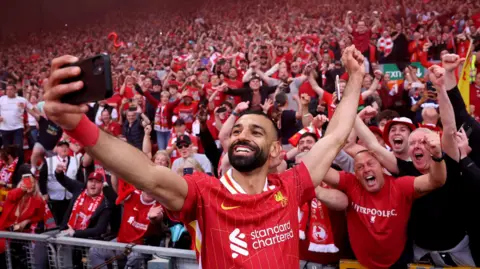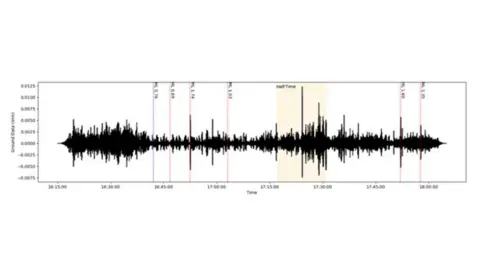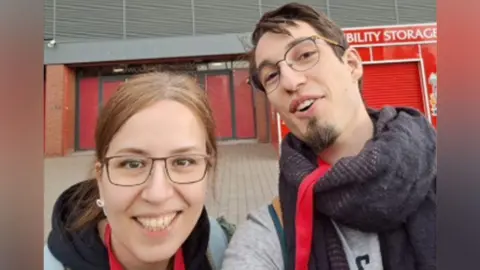Liverpool fans' celebrations caused earth tremor
 Reuters
ReutersLiverpool fans celebrating the club's historic title-clinching win over Tottenham Hotspur at Anfield caused a series of tremors, university scientists have revealed.
Arne Slot's side secured the club's 20th top-flight championship defeating Tottenham 5-1 in front of a packed Anfield stadium on 27 April.
The most significant tremor was caused by Alexis Mac Allister's strike in the 24th minute, which put Liverpool 2-1 ahead and registered a peak magnitude of 1.74 on the Richter scale.
The data was recorded by University of Liverpool earth scientists using equipment used to detect earthquakes.
 The University of Liverpool
The University of Liverpool EPA
EPACallum Harrison, a seismologist at the British Geological Survey, said the shaking experienced by fans was measured on "very sensitive equipment".
He said: "Seismic signals of this size have been observed at a number of concerts and sports fixtures over the past few years, including at Taylor Swift's concerts last year.
"Whilst the energy released at these events can be comparable to a small earthquake, it is generated by the crowd jumping or dancing and not from the creation of actual earthquakes."
The study was conducted by Dr Antoine Septier, Dr Farnaz Kamranzad, and Professor Ben Edwards from the University's Department of Earth, Ocean and Environmental Sciences department in partnership with the club.
"Much like natural seismic events, these goals produced bursts of ground-shaking, triggered by the sheer passion of Liverpool fans," Professor Ben Edwards said.
"Their enthusiasm was literally powerful enough to move the Earth."
 The University of Liverpool
The University of LiverpoolThe data revealed the 60,415-strong crowd generated real seismic activity, particularly in response to the goals scored during the game.
The second-largest tremor measured 1.60 and followed Mo Salah's goal in front of the Kop in the second half.
Cody Gakpo's effort measured in at 1.03, the own goal from Destiny Udogie 1.35 and Luis Diaz's initially disallowed equaliser 0.64.
 The University of Liverpool
The University of LiverpoolDr Farnaz Kamranzad said that while the tremors were small and not strong enough to be felt in the stands they were powerful enough "to leave a clear and lasting mark at Anfield".
"Every cheer, every celebration, leaves a trace beneath our feet, a seismic fingerprint of collective joy, written into the Earth's memory long after the final whistle," she said.
Dr Antoine Septier said he hoped the experiment would inspire a new generation of seismologists.
"I hope that showing this data will spark innovative ideas for potential applications, perhaps even to enhance the stadium experience," he said.
Listen to the best of BBC Radio Merseyside on Sounds and follow BBC Merseyside on Facebook, X, and Instagram. You can also send story ideas via Whatsapp to 0808 100 2230.

Get our flagship newsletter with all the headlines you need to start the day. Sign up here.
